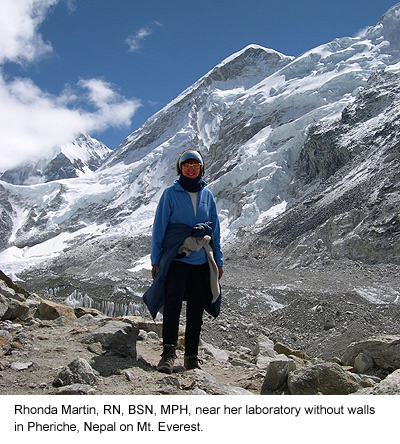Beyond The Walls of BWH

The blizzard started earlier than expected. I left Mt. Everest base camp
late in the day to head back to my research station several miles below. The lunar-like
tent-city faded behind me quickly as fog and snow rolled in. I tried to speed
my pace, but at close to 18,000 feet, the thin air starved my lungs of oxygen.
Scrambling along, I had the feeling I was drifting precariously close to
the edge that dropped into the crevassed glacier below. Ever so briefly, the fog
lifted to reveal that I was indeed perched at the edge of the precipice. In the
misty distance I spotted a lone porter heading down. Fortunately, he heard my
shout and waited, assisting me to get safely back. All in a day’s work in
a laboratory without walls.
In March 2004, I joined twenty doctors and medical students to do field research
on preventing altitude sickness, or acute mountain sickness (AMS) at Mt. Everest
base camp. AMS is an all-too-common problem among adventure travelers that can
be fatal. The study was sponsored by the Wilderness Medical Society (WMS), in
conjunction with the Himalayan Rescue Association (HRA).
Our study tested the efficacy of an herbal supplement and a pharmacological
agent alone and in combination, against a placebo in preventing acute mountain
sickness. The study will be published in a professional journal later this year.
We recruited trekkers and followed them from Lukla all the way along the 36-mile
valley to the base of Kala Patar. Despite the large numbers of trekkers in the
region, we found most declined participation in our study. Europeans preferred
to acclimatize gradually and Americans wanted the benefit of the pharmacological
agent instead of a placebo.
We experienced a myriad of other obstacles as well. Yaks and porters had to
be arranged to get our study gear into the mountains and stations set up with
meager resources. There was no means of communication between stations and our
colleagues. We employed creative measures wherever we could such as sending handwritten
messages with reliable trekkers. We called it the “Trekker’s Express.”
The experience taught me that remote field research is more important now than
ever. Conditions like AMS, once thought of as isolated to an elite group of mountain
climbers, now severely impact the US ski industry in high altitude locations.
By the same token, infectious diseases such as SARS, AIDS and West Nile Virus
have become global problems. As the world contracts, the role of field researchers
becomes the more critical in understanding once rare medical conditions and building
awareness among medical and nursing professionals.